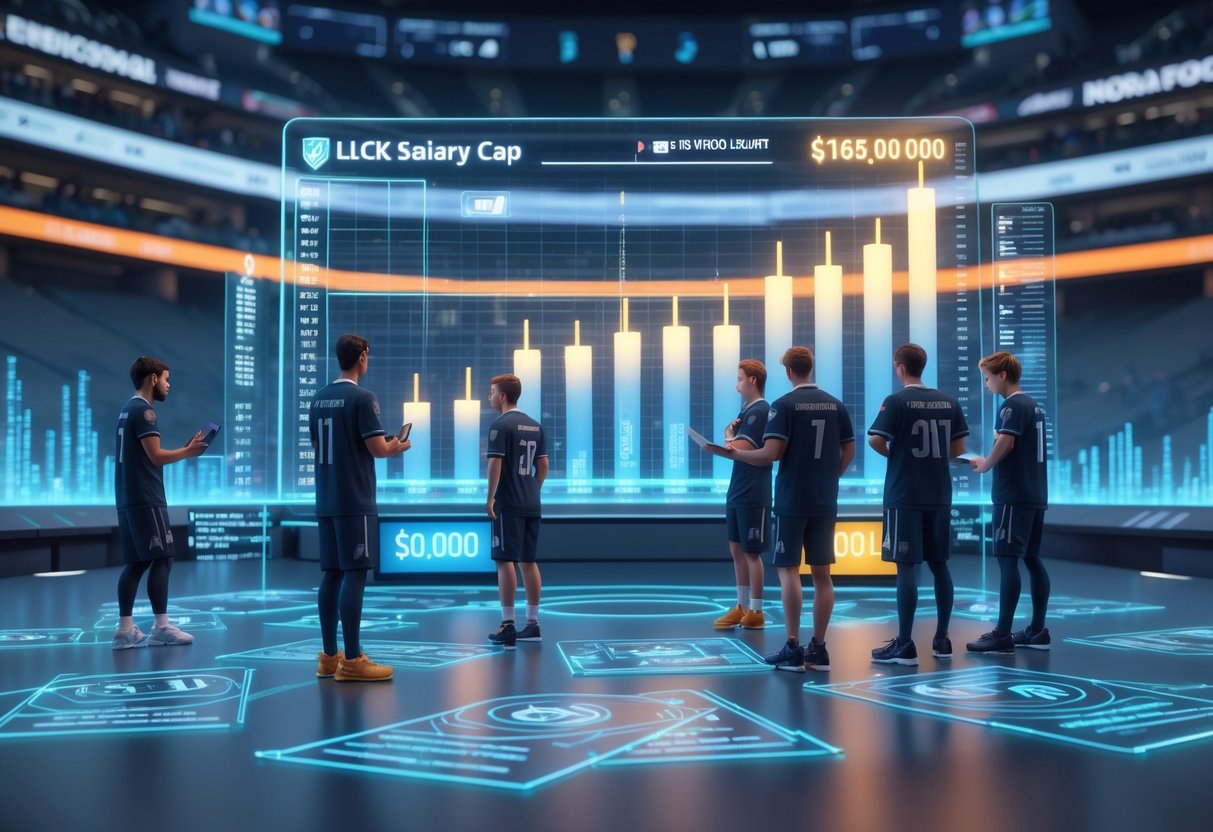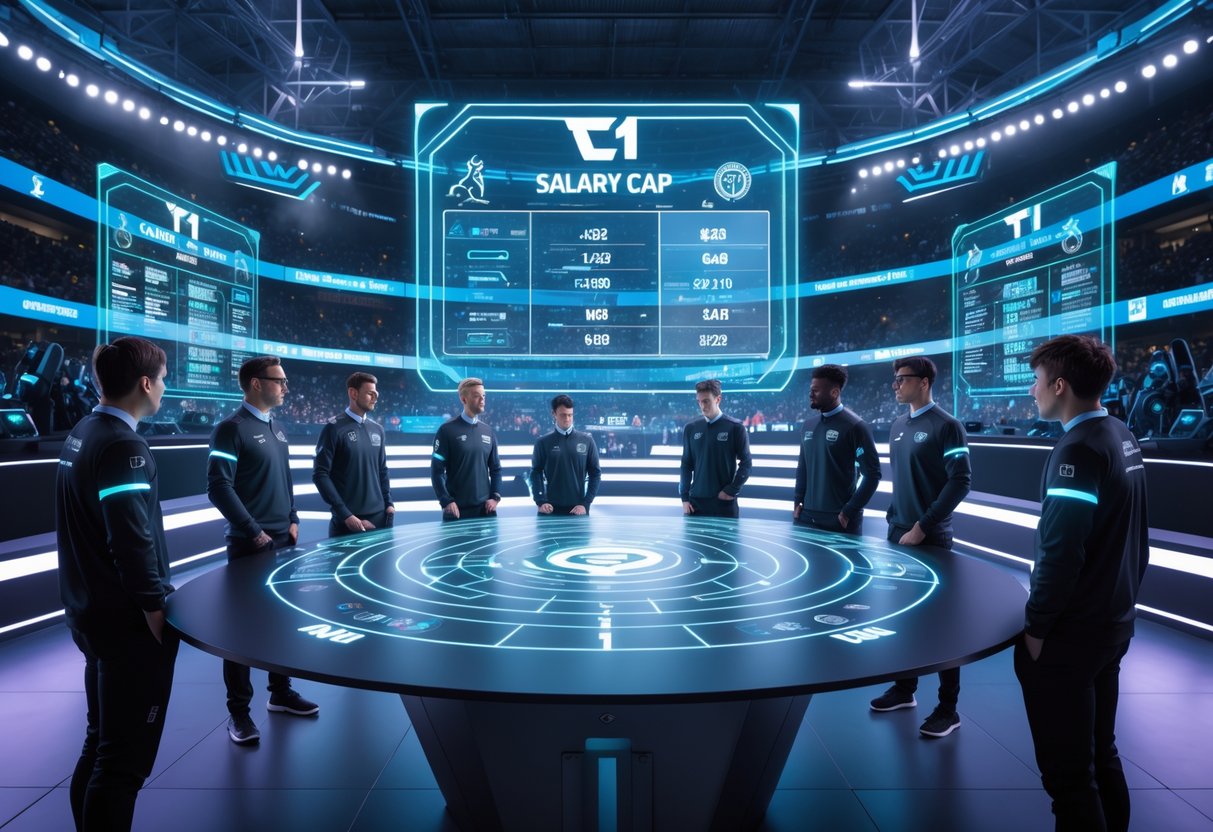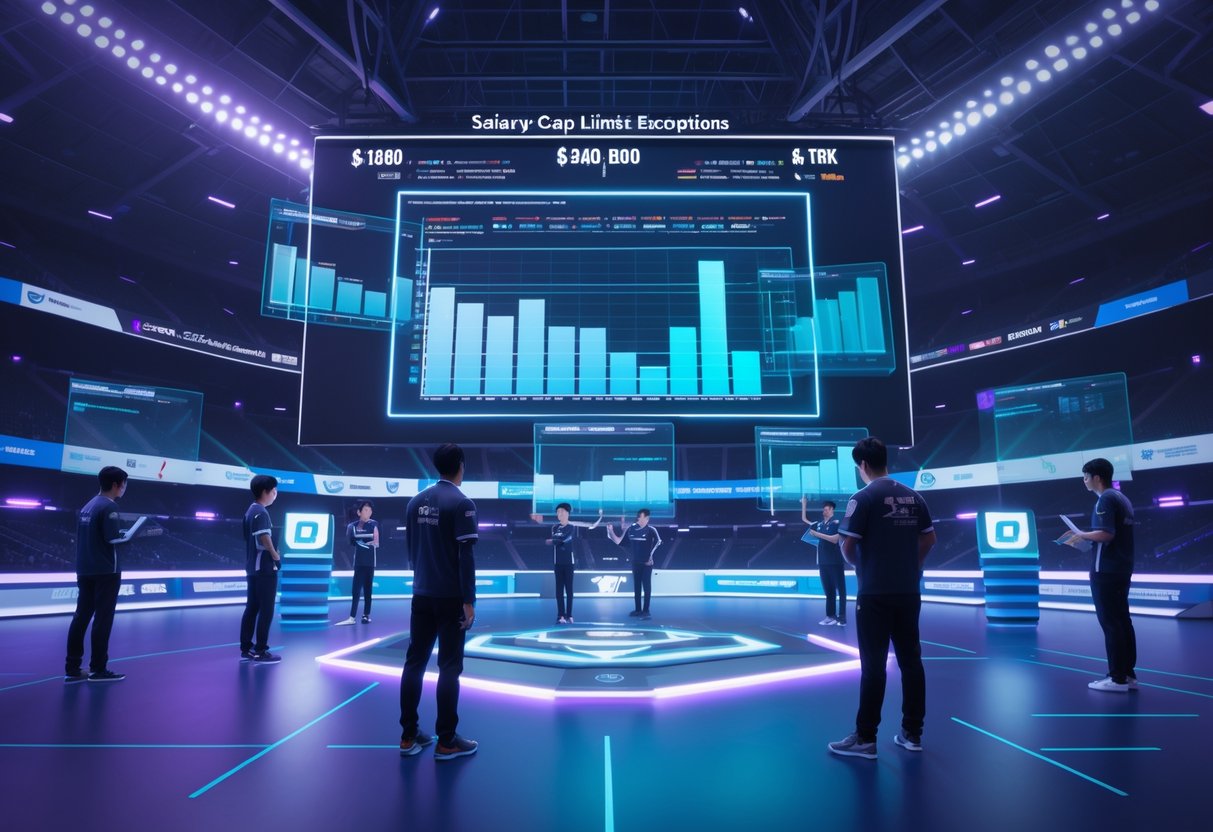LCK Salary Cap Introduction: Impact, Rules, and Esports Future
Updated On: October 23, 2025 by Aaron Connolly
LCK Salary Cap Introduction and Purpose
The LCK rolled out salary caps in 2024. They wanted to rein in player costs that were spiraling out of control and threatening the financial stability of teams.
All ten teams signed off on the rules after seeing salaries jump 71% in just two years—pretty wild, right?
Why the LCK Implemented a Salary Cap
By 2023, the LCK was staring down a serious money crunch. Player salaries had gotten so high that teams could barely keep their heads above water.
The numbers told the story. The top five players on each team saw their average pay shoot up 71% in two years. Most teams funneled nearly their entire budget into player wages.
Then COVID-19 hit and made everything worse. Sponsorships dried up, event income tanked, and teams just couldn’t find enough ways to stay in the black.
Ironically, the LCK’s own success caused some of these problems. As one of the top leagues worldwide, it drew in elite talent, and those players wanted to get paid what they felt they deserved.
Teams started to realize they needed some rules to protect themselves. Without limits, salary wars would push weaker orgs out of business. The league could’ve lost teams if nothing changed.
Initial Reactions from the Esports Community
T1 came out swinging against salary caps when the idea surfaced in 2022. They had the cash to pay big, so they didn’t want any restrictions holding them back.
Other teams actually welcomed the caps. Smaller orgs just couldn’t keep up with the spending and needed some kind of safety net.
Players themselves felt pretty conflicted. Some worried about taking home less money, but others saw that bankrupt teams meant less job security for everyone.
The community kicked off heated debates about whether caps would hurt competition. Some folks worried that limiting salaries might just send top talent packing for leagues like the LPL.
But by 2023, even T1 gave in and backed the cap. All ten teams finally agreed after looking at the financials. The alternative? Watching teams fold.
Comparison to Previous Financial Practices
Before 2024, the LCK didn’t bother with spending limits. Teams could throw as much money as they wanted at players. That led to massive gaps between the rich orgs and everyone else.
The LCK actually took a page from the LPL, which had already started using salary controls. Even traditional sports leagues like the NBA do this.
The old way looked like this:
- No salary limits at all
- No luxury taxes
- No real financial oversight
- Teams just tried to outspend each other
Now, the league uses several checks. Teams have salary caps, luxury taxes, and have to report their finances. Veteran players get special treatment as a nod to their achievements.
The league protected old contracts during the changeover. If a player signed before 2023, only one-fifth of their salary counts toward the cap. That helped teams ease into the new system.
Key Regulations of the LCK Salary Cap
The LCK’s Sporting Financial Regulations brought in a hard salary cap, luxury taxes, and special exemptions for veteran players. Teams now have to juggle strict spending limits and a handful of quirky salary calculation rules.
Upper and Lower Salary Limits
The LCK set salary limits for all ten teams starting in 2024. These limits only apply to the starting roster and give teams a framework for more sustainable spending.
If a team goes over the salary cap, they pay luxury tax penalties. The system borrows from traditional sports like the NBA. During the transition, luxury fees hit at 80% of the full rate, giving teams a little breathing room.
For starting rosters:
- The cap covers all five starters
- Combined salaries can’t go past the set ceiling
- Subs and academy players get calculated separately
The league wants to stop the runaway salary inflation that saw top earners’ pay jump 71% in two years. That spike put several LCK orgs at risk.
Luxury Tax System for Teams
If teams go over the cap, they pay luxury taxes, not face bans or forced roster changes. Rich orgs can still spend more, but they’ll pay for it, and that money helps keep the league balanced.
During the 2023-2024 transition, the luxury tax rate starts at 80%. After that, it jumps to the full rate. The league uses this extra cash to help smaller teams and league operations.
How it plays out:
- Teams total up roster salaries after exemptions
- They check it against the cap
- Anything over gets taxed
- The more you overspend, the more you pay
This setup nudges teams to spend wisely. But it doesn’t totally block them from signing stars. We’ve seen similar systems work in basketball and baseball.
Eligible Salaries and Exclusions
Several exemptions knock down how much of a player’s salary counts toward the cap. These rules reward veterans and encourage loyalty.
Key exemptions:
- Championship veterans: 50% off for players with 5+ LCK titles or 3+ international wins
- Long-term players: 30% off for three years on the same team
- Old contracts: Only 20% of pre-2023 deals count toward the cap
Teams can stack these exemptions, so a veteran’s impact on the cap can shrink a lot. For contracts signed before the 2023 Spring deadline, teams only count one-fifth of the actual salary, no matter what.
This “grandfather” rule helps teams avoid sudden penalties and rewards them for keeping players around.
Impact on Player Salaries and Contracts

The LCK salary cap completely changes how League of Legends teams handle player payments and write up contracts. Teams now have to stay inside spending limits, all while managing pricey deals with top-tier players.
How Player Salaries Are Calculated
The LCK sets a maximum teams can spend on their starting five. Teams have to count every bit—wages, bonuses, incentives—toward this total.
There’s a luxury tax, just like in the NBA. If teams go over the cap, they pay financial penalties instead of facing outright bans.
That gives teams some flexibility. Smaller orgs get a fairer shot against giants like T1 and HLE.
What counts toward the cap:
- Base annual pay
- Performance bonuses
- Signing bonuses (spread over the contract)
- Housing and meal allowances
Teams also have to budget for subs and coaching staff. The league wants to stop the wage inflation that’s been pushing most orgs into the red.
Exceptions for Top-Tier Players
The LCK salary cap leaves some wiggle room for teams to keep their big names. If a team wants to pay more, they can, but they’ll fork over extra cash through the luxury tax.
That means orgs like T1 can still shell out for world-class talent. They just have to pay a fee to the league for the privilege.
This system helps stop top players from jumping ship to other regions like the LPL or LCS. Teams worried about losing stars pushed for this compromise.
Why the luxury tax works:
- Keeps competition fair—no endless spending
- Lets teams keep stars—exceptions for elite players
- Boosts league revenue—taxes support smaller orgs
- Eases the transition—teams get time to adjust contracts
It’s a lesson straight from traditional sports: hard caps can drive talent away, but taxes let leagues keep their stars around.
Treatment of Existing Contracts
Teams with expensive contracts already on the books have the toughest time under the new cap. The league expects teams to rethink how they structure deals going forward.
Current contracts signed before the cap stay valid until they run out. Teams can’t force players to take pay cuts on existing agreements.
But any new deals or renewals have to fit within the new limits. That means teams with several pricey free agents have some tough calls to make.
What teams are doing:
- Shorter contracts with higher annual pay
- More bonuses tied to performance, less guaranteed cash
- Spreading costs across multiple years
- Focusing more on developing young, cheaper players
Some orgs might have to choose which stars to keep and which to let go. Teams are already shifting to building around one or two big names, then filling in the rest with budget-friendly options.
The cap gives teams a timeline to plan as expensive deals expire over the next few years.
Financial Health of LCK Organisations

The LCK didn’t just dream up salary caps for fun. Teams like T1 and Gen.G were bleeding money, and honestly, something had to give.
Revenue Calculations and Cap Determination
The LCK had to face the facts about team finances. Top player salaries jumped 71% in two years—not exactly sustainable.
Most LCK orgs now pour most of their budgets into player pay. That leaves little for things like facilities or coaching.
Even T1, who once fought against salary caps, changed their tune when the numbers got scary. They saw that endless bidding wars weren’t helping anyone.
League revenues just couldn’t keep up. Viewership dropped, sponsorships shrank, and teams ended up paying more while earning less.
Traditional sports ran into the same wall years ago. Salary caps stopped teams from collapsing, so the LCK decided to follow suit.
Sustainability for Esports Teams
The Sporting Financial Regulations try to keep teams afloat for the long haul. Without them, a few LCK teams probably would’ve gone under.
COVID-19’s hit on sports and esports still lingers. Teams lost sponsors and merchandise sales during the worst of it.
The LCK uses luxury taxes to stop reckless spending, but still lets teams go a bit over if they pay up. The more you overspend, the higher the penalty.
Veteran player exemptions help teams hang onto their best talent. Players with a stack of LCK titles can get up to 50% off their salary cap hit.
If a player stays with the same org for three years, the team gets a 30% reduction. That encourages loyalty and long-term planning.
During the transition, luxury tax rates stay at 80% so teams can adjust. Old contracts from before 2023 Spring only count as one-fifth of their value for the cap.
Influence on Competitive Balance
The LCK’s salary cap wants to even things out by capping roster spending. But honestly, those special exemptions for legends like Faker and Peanut might just shuffle the balance instead of flattening it.
Effects on Star Player Distribution
The exemption system creates some interesting quirks in how top-tier players move around. If you’ve won the LCK five times or taken three big international trophies, only half your salary counts against the cap.
Right now, that’s just Faker (T1) and Peanut (Gen.G). Because of these breaks, rich teams can still keep a couple of stars without blowing the cap.
Teams already stacked with superstars might keep their edge. The 30% discount for players loyal to one org for three years also helps the big names stay put.
Smaller orgs? They might have a tough time luring in top talent. They’ve got the same salary limits but none of the perks that help the big orgs.
League of Legends teams may have to double down on developing homegrown talent. The cap might push orgs to scout better and build up their own stars, instead of just buying them.
Challenges for Smaller Teams
The salary floor, set at 70% of each team’s 2022 revenue, puts immediate pressure on budget-conscious organizations. Teams have to spend this minimum on player salaries, whether or not they can actually afford top-tier talent.
Revenue sharing from the luxury tax offers some relief. Teams under the cap get payments from organizations that overspend.
But the exemption system really favors teams that already have decorated players. Smaller teams just don’t get the same salary cap breaks that come with signing someone like Faker.
New organizations especially struggle to compete for talent. They lack both the cash and the roster exemptions that established teams already enjoy.
The two-year review cycle means struggling teams have to wait for possible adjustments. Quick fixes through increased spending just aren’t possible anymore.
Comparison with Salary Caps in Other Leagues

The LCK salary cap borrows ideas from other major esports and traditional sports leagues. Each region tweaks these financial controls to fit their own market challenges and keep things balanced.
LCS and LPL Salary Cap Approaches
The LPL implemented salary caps first among the major League of Legends regions. Chinese teams were spending huge sums on Korean imports, which just wasn’t sustainable.
Their system limits total roster spending, not individual player salaries. Teams that go over the cap face luxury taxes and roster limits.
The LCS has talked about salary regulations but hasn’t put strict caps in place yet. North American teams seem more focused on import restrictions to control costs.
LCS organizations benefit from venture capital funding, so their financial pressures look different than Korean teams. This has delayed serious salary cap talks in North America.
The LCK’s approach looks a lot like the LPL model. Both regions limit total roster costs, but let teams exceed caps if they’re willing to pay penalties.
Lessons from Traditional Sports
Traditional sports provide salary cap models that esports can borrow from. The NBA’s luxury tax system lets teams overspend, but they pay escalating penalties for it.
Korean pro sports leagues already use salary caps with public wage disclosures. This transparency keeps fans’ trust and helps maintain balance.
Football’s Financial Fair Play rules focus on preventing big losses rather than capping spending outright. Some esports analysts wonder if that approach might actually fit this industry better.
Heads up: Unlike traditional sports, esports players can jump between regions easily, which makes global caps tough to enforce.
The main takeaway? Salary caps have to fit each league’s unique market and competitive needs.
Role of Leading Teams Like T1

T1 didn’t like salary caps at first, but changed their stance as financial losses piled up. Their heavy spending on stars like Faker played a big role in shaping the LCK’s new rules.
T1’s Position on the Salary Cap
T1 led the opposition to salary caps when talks started in 2021. The organization worried spending limits would block them from signing the best players.
By 2024, everything changed. T1 reported big operating losses, so salary controls started to look necessary. Financial struggles pushed them to join the other LCK teams in supporting the rules.
Gaming expert James Connolly points out that T1’s shift shows even top teams couldn’t keep up with rising costs. “When the biggest brand in Korean League of Legends admits they need spending limits, it signals a real crisis,” he says.
The final deal included special exemptions that helped T1 get on board. Players like Faker count for only 50% of their salary because of their achievements. That compromise let T1 keep their stars and support league-wide stability.
Impact on Roster Expenses
T1’s spending habits shaped the LCK’s salary cap. The rules focus on the top five highest-paid players per team because teams like T1 pour money into star talent.
The new system creates a luxury tax for teams that overspend. T1 will probably pay this tax, but the money goes to smaller teams, which helps even things out.
Long-term contracts get a boost under the new rules. Players who stay with T1 for three years or more get a 30% discount when calculating the salary cap. This rewards loyalty and helps teams manage their budgets.
So T1 can still spend big on players like Faker, but they’ll pay extra taxes that support other LCK teams. It should make the league more competitive overall.
Notable Player and Team Exceptions

The LCK salary cap includes special exemptions for veteran champions and loyal players. These rules protect top-tier talent from huge pay cuts and reward long-term commitment.
Special Rules for Veteran Champions
The biggest exception goes to legendary players who’ve won major titles. Anyone with 5 or more LCK splits or 3 Tier 1 international tournament wins gets a big salary cap break.
Only 50% of their salary counts towards the team’s cap. So, a veteran earning £1 million only uses £500,000 of the team’s salary budget.
Right now, just two players qualify: Faker from T1 and Peanut from Gen.G. Their championship history meets the requirements.
This rule protects the league’s biggest stars from big salary hits. Without it, top players might bolt for the LPL or LCS, where spending isn’t restricted.
Teams can build around these veterans without blowing their entire budget. It’s a real advantage for organizations willing to invest in proven winners.
Loyalty Incentives for Long-Term Players
Players who stick with one organization get valuable financial perks. After 3 years with the same team, 30% of their salary doesn’t count toward the cap.
This loyalty bonus kicks in for several high-profile players. Stars like Canyon, Gumayusi, and Showmaker qualify for these reductions right now.
The system rewards stability in a league known for constant roster changes. Teams can keep experienced cores together and manage their salary bills better.
For example, a loyal player making £600,000 would only count £420,000 against the cap. That gives both players and organizations a real reason to stick together.
These loyalty incentives stack with veteran exemptions. A qualifying player could see a big chunk of their salary excluded from cap calculations.
Fan and Community Perspectives

The LCK salary cap stirred up intense debate among League of Legends fans everywhere. People couldn’t agree on whether spending limits would help or hurt competitive balance.
Public Debate on Competitive Fairness
Fans are divided over whether salary caps make things fairer. Supporters say limits stop rich teams from buying all the best players.
Others worry about player freedom. They think restrictions might drive top Korean players to leagues like the LPL or LEC, where salaries could be higher.
Balance concerns keep popping up on Reddit. Fans wonder if teams like T1, who fought the cap at first, might lose their edge if they can’t outspend rivals.
The community also debates transparency. Korean sports leagues with caps usually publish player wages, and some fans want to see that level of openness in esports.
Community engagement on this topic has been huge. Fans keep asking whether the cap helps smaller teams or just limits what players can earn.
Currency Conversion and Salary Perceptions
Some fans think reported LCK salaries are inflated. According to fan discussions, currency conversion rates might make spending look bigger than it really is.
People have raised eyebrows at huge salary numbers reported for teams like T1 and HLE in 2024. There’s skepticism about whether overseas media convert Korean won to US dollars accurately.
Accuracy questions are everywhere on gaming forums. Fans debate whether the reported salary figures are real or if conversion mistakes are skewing perceptions.
The community’s frustrated by inconsistent reporting. Different sources give different numbers, making it tough to know what’s actually happening with salaries in League of Legends esports.
Potential Future Changes to Salary Cap Rules

The LCK plans to review and possibly tweak its salary cap system every two years. This flexible setup lets the league react to changing market conditions and team finances.
Scheduled Review Periods
The LCK set regular review periods every two years to check if the salary cap system still works. This gives teams time to adjust before any rule changes.
During reviews, league officials look at team spending and financial health. They also check if the cap makes sense for the current market.
Teams can share feedback about problems they’ve run into. If the salary floor’s too high for struggling teams, or the cap stops competitive signings, officials can hear about it.
The next big review should be around 2026. Still, the LCK could make smaller tweaks if serious issues pop up sooner.
Adaptations Based on Market Trends
The LCK salary cap will have to change as the esports market grows or shrinks. Player salaries in League of Legends have shot up in recent years, which is why the cap exists in the first place.
If sponsorship and broadcast revenue rises, the cap might go up too. That would let teams spend more on top players while staying within the rules.
League officials are also watching what happens in the LPL and LEC. If those regions change their rules, the LCK might adjust to stay competitive for player signings.
Economic factors outside esports could force changes, too. Things like inflation or shifts in Korea’s economy might push the league to keep the system fair for everyone.
The Broader Impact on League of Legends Esports

The LCK salary cap sets a precedent that could change how esports leagues everywhere handle financial rules and long-term sustainability. This move affects both immediate competition and the future of League of Legends as a global esports ecosystem.
Influence on Global Esports Ecosystem
The LCK’s salary cap has already started a ripple effect across other major League of Legends regions. The LEC is rolling out similar rules, and the LFL capped spending at €250,000 for 2025.
Regional Competition Balance
- LPL teams might lose their big spending edge over Korean organizations
- Western leagues could have a better shot at signing talent
- Smaller regions might keep more of their top players
This shift really changes the player transfer market between regions. Before, LCK teams could outbid most Western orgs for star players. Now, we might see more balanced international rosters.
The broader esports industry is watching all this closely. Other competitive gaming titles face the same financial headaches from rising salaries and unsustainable spending.
Cross-Title Implications
- Traditional sports-style salary management enters esports
- Investors might feel more confident in regulated scenes
- Player unions could form to protect athletes
Long-Term Growth Prospects
Salary caps could steady League of Legends esports finances and draw in more sustainable investment. Teams dealing with cash flow headaches now get predictable spending limits, which makes budget planning a little less stressful.
Financial Sustainability Benefits
- Team investors and sponsors take on less risk.
- Leagues can rely on more predictable revenue models.
- New organisations face lower barriers to entry.
This regulation might push teams to build out academy systems and youth programmes. Since teams can’t just buy a championship anymore, putting money into player development suddenly makes a lot more sense.
Competitive Innovation
- Coaching and support staff start to matter even more.
- Building a roster strategically becomes more important than just signing big names.
- Regional talent programmes get a bigger spotlight.
LCK’s salary cap experiment could end up shaping what other major esports titles do. It feels like competitive gaming is inching closer to the way traditional sports handle their business.
Frequently Asked Questions
The LCK salary cap has sparked plenty of questions about team building, compliance rules, and player movement. Here are some answers about how it affects roster construction, luxury tax penalties, and how the system stacks up against other leagues.
How will the new salary cap affect team compositions in the LCK?
Teams will have to make tougher calls about which players to keep. Before the cap, wealthy organisations just signed as many superstar players as they wanted.
Now, teams have to juggle talent and budget constraints. So, we’ll probably see fewer rosters overloaded with expensive talent.
Some teams might throw most of their budget at one or two stars, then fill the rest of the lineup with cheaper picks. Others could spread their spending more evenly across all five starters.
Academy players and rookies suddenly look more appealing. Teams can develop young talent at lower salaries instead of chasing pricey veterans.
What are the consequences for LCK teams that exceed the salary cap limits?
Teams that go over the salary cap get hit with a luxury tax, much like traditional sports. They pay extra on top of what they already spend on players.
The more teams overspend, the steeper the tax gets. A little over the line costs less than a wild spending spree.
Teams could also face sporting penalties, not just financial ones. The league hasn’t shared every detail yet, but there may be restrictions on transfers or draft picks.
Repeat offenders will get harsher punishments. Teams that keep breaking the rules could see bigger fines or even tougher sanctions.
Could you explain how the salary cap is calculated for LCK teams?
The LCK hasn’t given out exact numbers for their salary cap formula. Most pro sports leagues base their caps on total league revenue.
Main roster players count toward the cap. That’s the five starters you see in official matches.
Substitute and academy players probably fall under different budget rules. They usually earn less, so their impact on the cap is smaller.
Performance bonuses and prize money might not count toward the cap. Teams still get to reward success without busting their budgets.
In what ways does the LCK salary cap differ from other leagues around the world?
The LCK sticks pretty close to the LPL model instead of inventing something totally new. Both Asian leagues feel the same squeeze from rising player salaries.
Western leagues like the LEC don’t use salary caps right now. That gives European teams more freedom to spend, but it also means more financial risk.
The LCK’s luxury tax system borrows more from traditional sports than most other esports leagues. Teams can still overspend, but they have to pay for it.
Korean regulations push for more transparency. The league might even require public salary disclosures, which you hardly ever see in esports.
What measures are in place to ensure transparency and compliance with the LCK salary cap?
The league is thinking about public salary disclosure, just like in traditional Korean sports. That would make player contracts visible to fans and the media.
Teams have to submit financial documents to prove they’re following the rules. The LCK will audit these reports to spot violations.
Independent oversight makes it tougher for teams to sneak around the cap with hidden payments. Moving money under the table gets risky.
Regular checks during the season help catch problems early. Teams won’t just find out at the end of the year that they’ve broken the rules.
How might the salary cap introduction change LCK player transfers and signings?
Transfer fees will probably play a bigger role when teams value players. Now, organizations have to look at both the salary and the transfer payment before they sign anyone.
Contract timing suddenly feels a lot more critical. Some teams might decide to let go of pricey players before the salary cap period kicks in, or maybe they’ll just wait things out until it’s over.
Free agents gain some bargaining power here. If a team has room under the cap, they can throw bigger salaries at top players to convince them to join.
I could see more international transfers happening too. Players might look overseas for better pay, especially since European and North American teams don’t have these caps and might just make irresistible offers to Korean stars.


